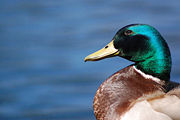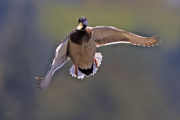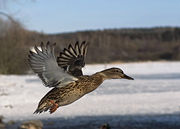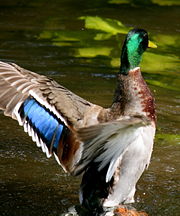Mallard
2008/9 Schools Wikipedia Selection. Related subjects: Birds
| Mallard | ||||||||||||||||
|---|---|---|---|---|---|---|---|---|---|---|---|---|---|---|---|---|
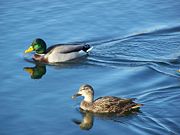 Male (top) and female (bottom)
|
||||||||||||||||
| Conservation status | ||||||||||||||||
| Scientific classification | ||||||||||||||||
|
||||||||||||||||
| Binomial name | ||||||||||||||||
| Anas platyrhynchos Linnaeus, 1758 |
||||||||||||||||
| Subspecies | ||||||||||||||||
|
See Mexican Duck, Anas and below |
||||||||||||||||
| Synonyms | ||||||||||||||||
|
Anas boschas |
The Mallard (Anas platyrhynchos), probably the best-known and most recognizable of all ducks, is a dabbling duck which breeds throughout the temperate and sub-tropical areas of North America, Europe, Asia, New Zealand (where it is currently the most common duck species), and Australia. It is strongly migratory in the northern parts of its breeding range, and winters farther south. For example, in North America it winters south to Mexico, but also regularly strays into Central America and the Caribbean between September and May.
The Mallard and the Muscovy Duck are believed be the ancestors of all domestic ducks.
The Agreement on the Conservation of African-Eurasian Migratory Waterbirds ( AEWA) applies to the mallard.
Description
The mallard is 56–65 cm long, has a wingspan of 81–98 cm, and weighs 2-2 1/2 pounds. The breeding male is unmistakable, with a green head, black rear end and a yellow bill tipped with black (as opposed to the dark brown bill in females). The female Mallard is light brown, like most female dabbling ducks. However, both the female and male Mallards have distinct purple speculum edged with white, prominent in flight or at rest (though temporarily shedded during the annual summer molt). In non-breeding ( eclipse) plumage the drake becomes drab, looking more like the female, but still distinguishable by its yellow bill and reddish breast.
The Mallard is a rare example of both Allen's Rule and Bergmann's Rule in birds. Bergmann's Rule, which states that polar forms tend to be larger than related ones from warmer climates, has numerous examples in birds. Allen's Rule says that appendages like ears tend to be smaller in polar forms to minimize heat loss, and larger in tropical and desert equivalents to facilitate heat diffusion, and that the polar taxa are stockier overall. Examples of this rule in birds are rare, as they lack external ears. However, the bill of ducks is very well supplied with blood vessels and is vulnerable to cold.
The size of the Mallard varies clinally, and birds from Greenland, although larger than birds further south, have smaller bills and are stockier. It is sometimes separated as subspecies Greenland Mallard (A. p. conboschas).
In captivity, domestic ducks come in wild-type plumages, white, and other colours. Most of these colour variants are also known in domestic mallards not bred as livestock, but kept as pets, aviary birds, etc., where they are rare but increasing in availability.
A noisy species, the male has a nasal call, the female the " quack" always associated with ducks.
Ecology
The Mallard inhabits most wetlands, including parks, small ponds and rivers, and usually feeds by dabbling for plant food or grazing; there are reports of it eating frogs. It usually nests on a river bank, but not always near water. It is highly gregarious outside of the breeding season and will form large flocks, which are known as a sord.
